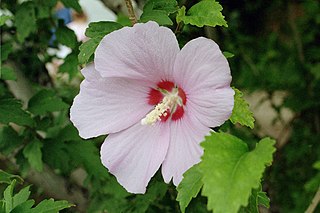
Hibiscus is a genus of flowering plants in the mallow family, Malvaceae. The genus is quite large, comprising several hundred species that are native to warm temperate, subtropical and tropical regions throughout the world. Member species are renowned for their large, showy flowers and those species are commonly known simply as "hibiscus", or less widely known as rose mallow. Other names include hardy hibiscus, rose of sharon, and tropical hibiscus.

Hibiscus syriacus is a species of flowering plant in the mallow family, Malvaceae. It is native to south-central and southeast China, but widely introduced elsewhere, including much of Asia. It was given the epithet syriacus because it had been collected from gardens in Syria. Common names include the rose of Sharon,, Syrian ketmia, shrub althea, and rose mallow. It is the national flower of South Korea and is mentioned in the South Korean national anthem.

Hibiscus rosa-sinensis, known colloquially as Chinese hibiscus, China rose, Hawaiian hibiscus, rose mallow and shoeblackplant, is a species of tropical hibiscus, a flowering plant in the Hibisceae tribe of the family Malvaceae. It is widely cultivated in tropical and subtropical regions, but is not known in the wild, so that its native distribution is uncertain. An origin in some part of tropical Asia is likely. It is widely grown as an ornamental plant in the tropics and subtropics.
Hawaiian hibiscus are seven species of hibiscus native to Hawaii. The yellow hibiscus is Hawaii's state flower. Most commonly grown as ornamental plants in the Hawaiian Islands are the Chinese hibiscus and its numerous hybrids, though the native Hibiscus arnottianus is occasionally planted.

Hibiscus tiliaceus is a species of flowering tree in the mallow family, Malvaceae, that is native to the Old World tropics. Common names include sea hibiscus, beach hibiscus, coastalhibiscus, coastalcottonwood, green cottonwood, native hibiscus, native rosella, cottonwood hibiscus, kurrajong, sea rosemallow, balibago (Tagalog), malabago or malbago, maribago, lambago, waru (Javanese), baru or bebaru (Malay), pagu (Chamorro), hau (Hawaiian), fau (Samoan), purau (Tahitian), and vau tree. The specific epithet, "tiliaceus", refers to its resemblance of the leaves to those of the related Tilia species.

Hibiscus clayi, common names red Kauai rosemallow, Clay's hibiscus or Kokiʻo ʻula, is a perennial angiosperm of the mallow family Malvaceae.

Hibiscus moscheutos, the rose mallow, swamp rose-mallow, crimsoneyed rosemallow, or eastern rosemallow, is a species of flowering plant in the family Malvaceae. It is a cold-hardy perennial wetland plant that can grow in large colonies. The hirsute leaves are of variable morphology, but are commonly deltoidal in shape with up to three lobes. It is found in wetlands and along the riverine systems of the eastern United States from Texas to the Atlantic states, its territory extending northward to southern Ontario.

Hibiscus fragilis, the mandrinette, is an extremely rare shrub that is endemic to steep slopes of the mountains Corps de Garde and Le Morne Brabant on Mauritius and from two further plants on Rodrigues. The mandrinette is an evergreen plant with flowers 7–10 cm diameter with five bright pink to carmine red petals.
Hibiscus dioscorides is a species of flowering plant in the family Malvaceae. It is found only in Yemen. Its natural habitat is rocky areas.
Hibiscus diriffan is a species of flowering plant in the family Malvaceae. It is found only in Yemen. Its natural habitat is rocky areas.
Hibiscus escobariae is a species of flowering plant in the family Malvaceae. It is found only in Ecuador. Its natural habitat is subtropical or tropical dry forests.
Hibiscus macropodus is a species of flowering plant in the family Malvaceae. It is found only in Yemen.
Hibiscus malacophyllus is a species of flowering plant in the family Malvaceae. It is found only in Yemen. Its natural habitats are subtropical or tropical dry forests and subtropical or tropical dry shrubland.
Hibiscus noli-tangere is a species of flowering plant in the family Malvaceae. It is found only in Yemen. Its natural habitat is subtropical or tropical dry forests. It is threatened by habitat loss.
Hibiscus quattenensis is a species of flowering plant in the genus Hibiscus, in the family Malvaceae. It is found only in Yemen. Its natural habitat is subtropical or tropical dry shrubland.

Hibiscus scottii is a species of flowering plant in the family Malvaceae. It is found only in Yemen. Its natural habitat is subtropical or tropical dry forests.
Hibiscus socotranus is a species of flowering plant in the family Malvaceae. It is found only in Yemen. Its natural habitat is subtropical or tropical dry shrubland.
Andropogon bentii is a species of grass in the family Poaceae. It is found only in the Socotra archipelago in the Indian Ocean, a part of Yemen. Its natural habitat is succulent and dwarf shrubland on limestone escarpments and plateaus.

Rhodocactus stenanthus is a species of cactus that is endemic to Brazil. First described as Pereskia stenantha, it was transferred to Rhodocactus in 2016. Like all species in the genus Rhodocactus, and unlike most cacti, it has persistent leaves. In its native locality, it is sometimes used in hedges.
Lyndley Alan Craven was a botanist who became the Principal Research Scientist of the Australian National Herbarium.










